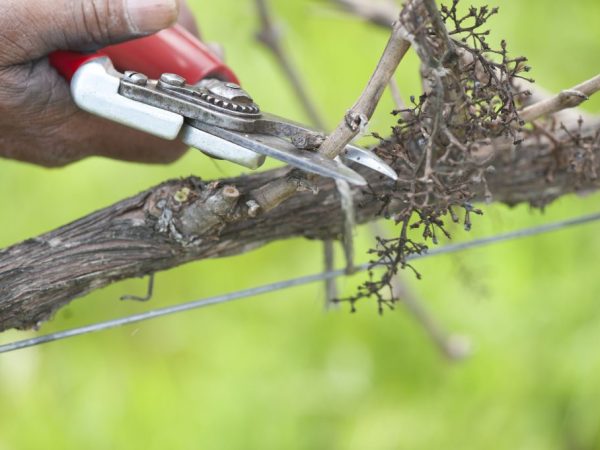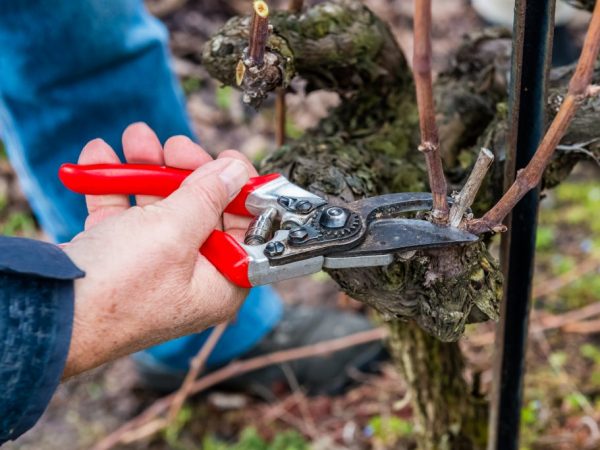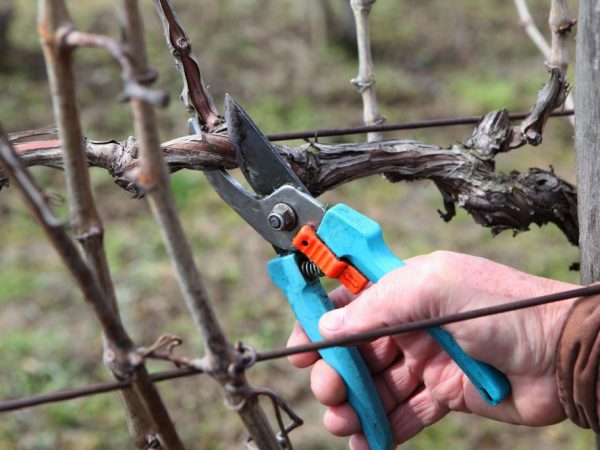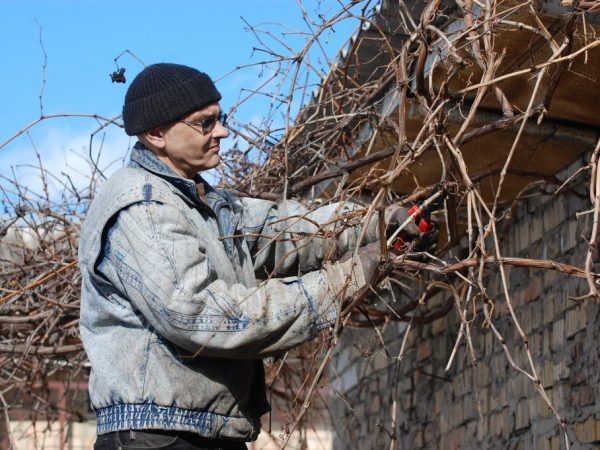Features of pruning grapes in spring
A good yield of grapes depends on the quality of the care measures. One of the most important procedures is grape pruning in the spring. How it is carried out depends on the condition of the vine, as well as the quality and quantity of the harvest.
- The importance of pruning grapes
- Spring pruning
- Autumn pruning
- Preparing for pruning
- Components of the plant
- Favorable time for spring formation
- Preparatory activities
- Recommendations for work
- Features of the formation of a bush
- Stamping
- Forming without a stem
- Formation of old plants
- Special trimming
- Care after pruning
- Growing on an arch or gazebo
- Conclusion

Features of pruning grapes in spring
The importance of pruning grapes
Grapes love warmth and sun. It grows and develops continuously, spreading shoots in all directions. The randomness and unevenness of young branches leads to problems with the formation of eyes. Self-development of culture, neglect of formation lead to the appearance of barren flowers, and they are a guarantee of a bad harvest. The berries become small and lose their taste.
Pruning grapes in the spring and autumn is necessary to avoid a bad harvest. The bush is formed already from the age of one.
Spring pruning
In spring, the goal of pruning is to redirect the plant's nutrients from the young upper branches to the stronger ones that are ready to bear fruit. Other important features of pruning in spring are associated with thinning of standard and non-standard bushes, as well as with the preservation of varietal characteristics of the culture. It is possible to get a good tasty harvest only by pruning according to the rules. Only unnecessary parts of the shoots are removed.
Autumn pruning
Autumn pruning has no less effect on yield and is necessary for the formation of the vine in the following seasons. To increase yields in the fall, only covering varieties are pruned (Isabella, Lydia, etc.).
Preparing for pruning

Sharpened pruning shears will make it easier to prune grapes
Having decided to prune the grapes, in the spring you should take care of the preparatory measures. It is important to prepare the necessary tools, sharpen and disinfect them, waiting for a favorable time to start gardening.
To organize the pruning of grapes in spring, it is important for beginners to understand the constituent parts of the bush and the significance that they have for the formation of a plant. Only after obtaining theoretical knowledge do they begin to form the bushes of the plant.
Components of the plant
In determining the constituent parts of the bush, great importance is attached to its age. So, the grape bush is divided into 3 components. These include:
- annual shoots;
- biennial shoots;
- old shoots (three years and more).
Taking into account the external features of development, shoots can have branches - sleeves. Each of them has fruit links, differing in small processes with 2-4 eyes. One shoot also grows, the number of eyes on which is greater than on the others. Only previously fruiting shoots become branches.
The fruit parts are the parts of the plant that have grown from last year's wood.The shoots that appear on the branches of a three-year (4 or 5-year-old) shoot are tops. You will get a harvest from them only after the season, if you cut it off in the spring.
Pruning young grapes in the spring helps with knowing the plant parts. Their age is distinguished by color. A two-year-old shoot has a gray or brown bark. In the one-year-old, it is golden. Annual shoots grow from replacement buds present on 2-year-old parts of the seedling.
Favorable time for spring formation
The start time of spring work depends on the climatic conditions for growing the crop. In temperate regions, gardening begins in early March. The dried branches are removed, and the plants themselves are treated with a solution of copper sulfate.
The recommended end time for pruning is mid-March. Started at this time is completed due to the onset of the period of sap flow, which often falls on the end of March-beginning of April.
Certain nuances concern vineyards located next to lakes and rivers. Cultivation of crops in such places often leads to more extensive damage to plants, therefore, more attention has to be paid to such plantings.
Preparatory activities
Before pruning grapes, in the spring, pay attention to preparatory measures. This is especially true for the tool. For work, a pruner and a regular saw are required.
The cutting tool must be sharp and clean. The readiness of the secateurs and saws for gardening is checked as follows:
- take a cutting tool and a regular sheet of paper;
- fold the sheet in half and hold it along the blade;
- if the paper is easy to cut, the tool is sharp.
It is necessary to prune the grapes in the spring when the air temperature is above 5 ° C. Before going out into the garden, wipe the cutting tool with an alcohol-based product.
Recommendations for work

Create a grape growth shape ourselves
Step-by-step instructions for forming a bush:
- The cut is performed at a right angle. This promotes faster healing of the cut.
- It does not matter which pruning scheme is chosen by the gardener, all dry and frozen branches are removed first.
- Long branches are not left. For effective development of the plant, 7-12 buds are enough.
- Removal of an annual shoot, which has already borne fruit, is done carefully so as not to damage parts of the lignified branch of the plant.
- A vine 6-8 cm thick is ready for active fruiting. All thinner and fattening branches are removed.
After completing the work, the plant can seem small and rare. Already after 1-2 months, a green mass appears, and with it new shoots and inflorescences grow. The description of the procedure for forming a bush depends on the method chosen by the gardener.
Features of the formation of a bush
For the correct formation of the bush, its age must be taken into account. Young plants grow and spread over trellises, arches, etc. The plant is formed according to one of the schemes: standard or non-standard pruning.
The features of the development of the culture itself are also important. Most often, plants are formed, the age of which is 3-4 years. It is then that the "sleeves" are singled out and everything necessary for their development and the appearance of inflorescences is done.
The plan for pruning grapes in spring is determined by the gardener. With the standard type, a powerful trunk is formed, from which the sleeves are diverted. The goal of the second is to form the shoulders from the basal head.
Stamping
This method is only effective when growing a non-covering crop. It is important that the plants are frost-resistant.
Formation according to this method is carried out from the first year after planting the seedling in the ground:
- At 1 year, the top is cut into 2 eyes (count from the root). The rest of the young growth is also removed.
- For 2 years, the stem is not touched. Attention is paid only to last year's parts of the plant. The most powerful one is cut so that 7-12 buds remain on it, 2-3 eyes are left on the rest.
- At 3 years old, attention is paid to the height and shape of the plant.The sleeves are shortened by 2 kidneys, after which they are tied up. A replacement knot is made from a short vine, shortening it by 2 buds, and 7-8 eyes are left on the second.
- For 4 years, the upper sleeves and excess processes are cut off.
- For the 5th year, everything is removed except for the branches that form the fruit link.
- At the 6th year, the replacement knot is cut into 2 buds. The arrow is shortened to 6-7 eyes.
The main advantage of this method of formation is the economy of space with a potentially high yield. Punching is effective when growing wine grapes: it helps to get a rich harvest, while maintaining the varietal qualities of the plant.
Forming without a stem
After shaping without a stem in the spring, the first harvest is obtained after 3 years. The main thing is to adhere to a number of rules:
- In the first year, dried and rotten parts of the plant are removed. Most of the young growth is also removed. Only 2 sprouts remain, which are shortened 3 cm above 2 buds.
- In the second year, 60% of the young growth is removed. Of the 2 remaining last year's sprouts, only 2 vines are left, which are shortened by 2-3 buds.
- In the third year, the fruit links are formed. The replacement knot is cut by 2-3 eyes, and the fruit arrow - by 7-8 eyes.
A few replacement knots are left: they are necessary for the development of the plant. Fruit-bearing branches are also needed.
Formation of old plants
The formation of an already mature plant in the spring is intended to regulate the parts of the plant. This stimulates renewal.
Cut off both the fruiting branches and damaged or weak parts. Fatty foods are also removed: they consume too many nutrients and do not produce a crop.
Special trimming

Cutting off damaged branches
Spring pruning of grapes is sometimes hampered by weather conditions. In some regions there are winters, leading to frostbite of certain parts of a young or old bush.
If the grower noticed damage on the bush in early spring, it is important to restore the plant in a timely manner.
The most common problems and tips for emergency pruning are:
- The bushes were frozen due to the cold in winter. Make incisions in the kidneys. A brown or black color indicates frostbite. If there are less than 80% of such eyes, the fruit links should contain more buds than with conventional pruning. With more damage, you will have to remove all frozen shoots and sleeves.
- Frostbite of the root system. It is necessary to gain access to the roots by carefully excavating the soil. The root is cut. Brown color indicates frostbite. The frozen parts are removed, leaving the roots slightly damaged.
- Hail damage. It is expressed by the loss of part of the leaves. Young shoots are cut to 1-2 eyes. In April-May, the young shoots that appear are thinned out.
- Spring frosts. They threaten to damage annual shoots and buds. The best remedy is short pruning of the vine.
By taking the appropriate measures, it will be possible to restore the intact parts of the plant, preserve the chances of harvest and prepare the grapes for flowering. All pruning operations are carried out in March, until the sap flow begins.
Care after pruning
After the spring pruning of grapes, sap flow is expected and the bushes are examined. Often, wounds form at the cut sites, the plant cries. Help should be provided as soon as possible, especially for large cuts.
If the plant cries, it is treated:
- covering the cut with paint;
- filling it with wax;
- spraying with a 1.5% solution of magnesium chlorate;
- processing with garden pitch;
- dragging the vine with wire.
The last procedure should be performed with the greatest care. It is important not to overtighten the wire to avoid drying out the vine. And the wire itself must be soft (use aluminum or copper). Wrap it around the vine in a place located 1-2 cm from the cut.Once the juice stops flowing out of the wound, the wire can be loosened.
Other care steps are simple. Having carried out the spring pruning of the grapes, they monitor the regular feeding, watering, and tying. The latter is most important, especially during the fruiting period. Securely fastened shoots will help the plant to withstand the load of the emerging and maturing brushes.
Growing on an arch or gazebo
Some gardeners prefer to grow the crop on an arch or gazebo. In the desire to get a shaded area, beginners can make a mistake: plant a covering grape variety. For such growing conditions, only frost-resistant varieties are suitable. Pruning of such plants is carried out, paying attention to some of the nuances.
For beginners, it is better to give preference to wild varieties. A girlish variety is also suitable. Such plants are unpretentious to care for, do not require a garter, cling to any support, ledge or surface, braiding the walls of a gazebo or arch. Maintenance of such plants is minimal. In the spring, remove old, dried or damaged shoots. There are no restrictions on the removal of overgrown vines.
If the plant is grown only for decorative purposes, no special attention is paid to the formation. Even a neglected wild grape gives a person the desired shade. Formlessness spoils the aesthetic appearance of the gazebo or arch.
Conclusion
For correct pruning of grapes in spring, the varietal belonging of the culture, its age and time of formation are taken into account. Especially in need of pruning varieties of non-covering type. Only unnecessary parts of the shoots are removed. This avoids mistakes and maintains the health of the planted bushes.
Spring pruning is different for young and old bush. In the case of the former, one strong shoot is created for the sleeve (the rest is removed as much as possible). For the old, pruning is carried out into 3-4 or 5-6 eyes, which are necessary for the formation of fruit arrows and the further development of the plant.


